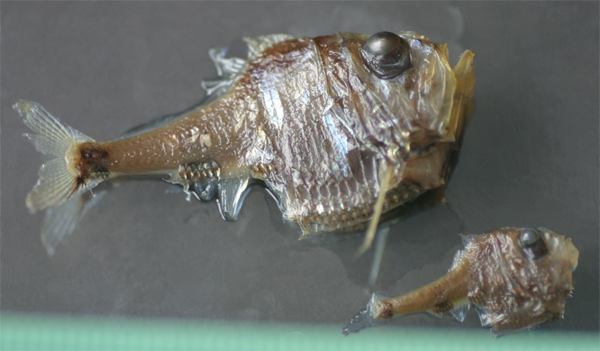
SUPERORDER STENOPTERYGII
The stenopterygians are a group of around 2000 species of temperate to tropical deep sea fish, among which are the most abundant species of fish in the world! Surprisingly perhaps, as can be seen here, most of these fish are very small presumably because the deep seas they inhabit do not provide them with very much food. Teleosts are primarily dependent on sight but some of those that live in the lightless conditions of the ‘deep sea’ have evolved ways of producing their own light and some predatory deep sea fish use their ‘lights’ to attract prey. Our collections include several species of stenopterygians which were not originally placed on display as they were deemed to be rather small and unattractive but here they are.
ORDER STOMIIFORMES
This order comprises 250 species of flesh-eating deep sea fish with wide gaping toothed mouths found world wide. Most are black and silvery and most lack scales. They may reach 35 cm in length. Many have luminous organs and many have a luminous barbel, which acts to lure their prey.
Family Gonostomatidae. The 75 species of bristlemouths are extraordinarily abundant at great depths in many parts of the world’s oceans.
 |
 |
1. Gonostoma elongatum, the bristlemouth. A large horizontal mouth, many small teeth and fine gill rakers enable the bristlemouth to feed on large prey. Its body is lined with light organs. This specimen is 22 cm long.
2. Cyclothone microdon, the veiled anglemouth. Members of this genus are more numerous than any other fish. They live at great depths feeding on small crustaceans and other invertebrates. Most species are quite small, i.e. less than 5cm, and they provide a most importanct source of food for larger fish. This specimen was collected by the Norwegian research vessel the ‘Michael Sars’ during its four month collecting trip in the Atlantic Ocean in 1910. This specimen is 5 cm long.
Family Stomatidae. The 175 species of scaled dragonfish are dark-coloured, fearsome-looking, small deep sea predators with a chin barbel and a large mouth full of fangs.

Stomias boa boa, the scaled dragonfish. This elongated predator of the Indo-Pacific and Atlantic Oceans undergoes extensive daily vertical migrations. Its hexagonal scales form a honey comb pattern. It has two rows of light organs along its ventral margins. This fish is usually less than 30 cm in length; this specimen is 25.5 cm long.
Family Sternoptychidae. The 50 species of hatchetfish are second in abundance only to the bristlemouths. Deep-chested but laterally compressed, their narrow dorsal profile conceals them above from predators and prey alike. They are very small, less than 10 cm in length, but have very large mouths, strange looking upwardly directed large tubular eyes and large photophores on their silvery sides which may serve to attract prey. They move up and down the water column preying on copepods and migrating zooplankton.

Argyropelecus hemigymnus. Half-naked hatchetfish. The large one is 5 cm long; the small one only 1.5 cm.






